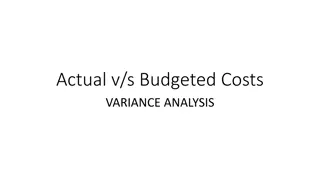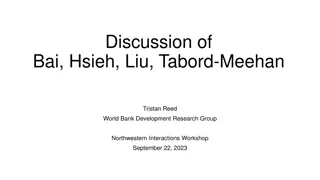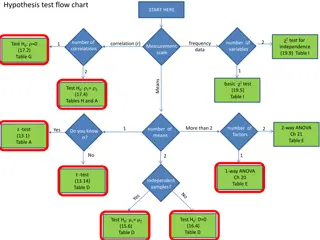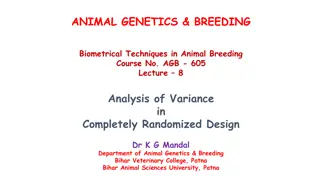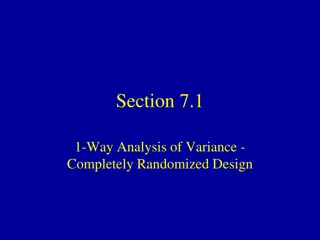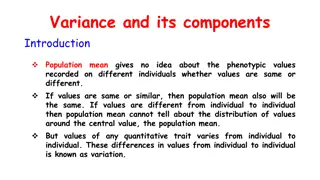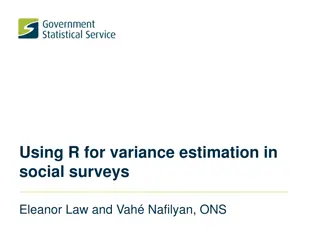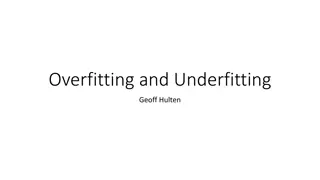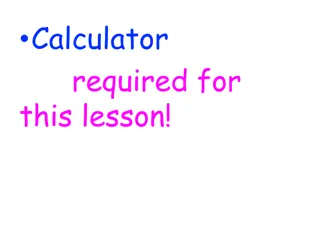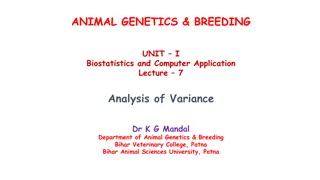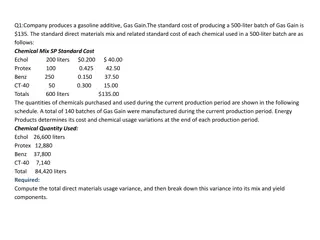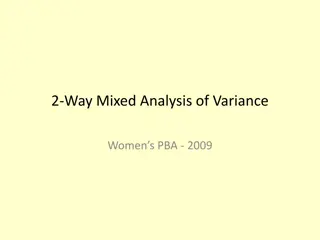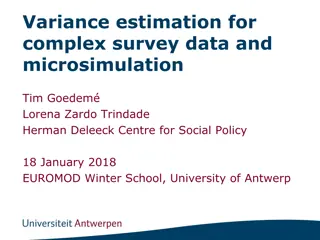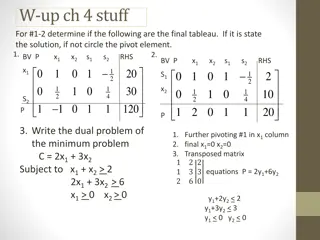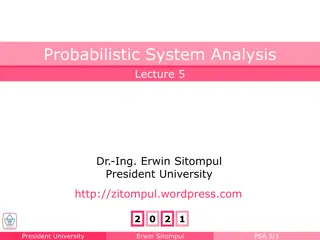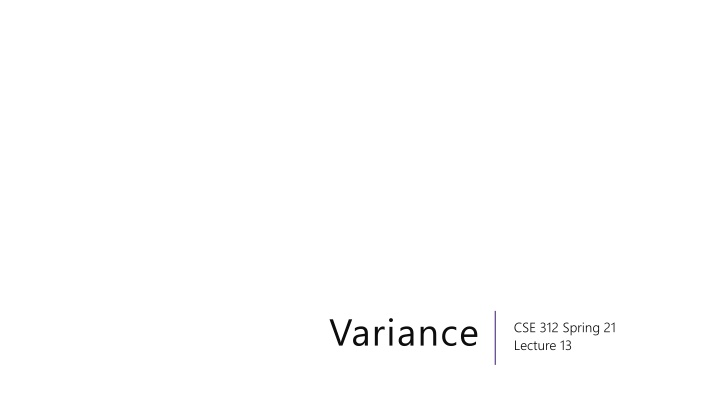
Understanding Random Variables and Variance in Statistics
Learn about random variables, expectation, and variance in statistics with examples such as fair coin games and how measuring the extremes and likelihood of outcomes is essential beyond just average values. See how designing a measure helps in understanding and quantifying variability in different scenarios.
Download Presentation

Please find below an Image/Link to download the presentation.
The content on the website is provided AS IS for your information and personal use only. It may not be sold, licensed, or shared on other websites without obtaining consent from the author. If you encounter any issues during the download, it is possible that the publisher has removed the file from their server.
You are allowed to download the files provided on this website for personal or commercial use, subject to the condition that they are used lawfully. All files are the property of their respective owners.
The content on the website is provided AS IS for your information and personal use only. It may not be sold, licensed, or shared on other websites without obtaining consent from the author.
E N D
Presentation Transcript
Variance CSE 312 Spring 21 Lecture 13
Announcements Two typo fixes in the homework. Problem 1, the example lost a negative sign Problem 6, the example s second bullet assigned one test to two people (that can t happen). It s corrected on the webpage as well. Office hour shifts this week: Robbie will stay after B lecture longer today (until about 3) Howard s OH today are cancelled; moved to Wednesday 10:30
Where are we? A random variable is a way to summarize what outcome you saw. The Expectation of a random variable is its average value. A way to summarize a random variable Expectation is linear ? ? + ? = ? ? + ?[?]. ? + ? is a random variable it s a function that outputs a number given an outcome (or, here, a combination of outcomes). linear
Variance Another one number summary of a random variable. But wait, we already have expectation, what s this for?
Consider these two games Would you be willing to play these games? Game 1: I will flip a fair coin; if it s heads, I pay you $1. If it s tails, you pay me $1. Let ?1be your profit if you play game 1 Game 2: I will flip a fair coin; if it s heads, I pay you $10,000. If it s tails, you pay me $10,000. Let ?2be your profit if you play game 2. Both games are fair (? ?1 = ? ?2 = 0)
Whats the difference Expectation tells you what the average will be But it doesn t tell you how extreme your results could be. Nor how likely those extreme results are. Game 2 has many (well, only) very extreme results. In expectation they cancel out but if you can only play once it would be nice to measure that.
Designing a Measure Try 1 Well let s measure how far all the events are away from the center, and how likely they are ? ? ? ? ? ? What happens with Game 1? 1 2 1 0 +1 What happens with Game 2? 1 2 100000 0 +1 5000 5000 = 0 2 ( 1 0) 2 ( 100000 0) 1 2 1 2= 0
Designing a Measure Try 2 How do we prevent cancelling? Squaring makes everything positive. 2 ? ? ? ? ? ? What happens with Game 1? 1 2 1 02+1 What happens with Game 2? 1 2 100000 02+1 5,000,000,000 + 5,000,000,000 = 1010 2 1 02 2 100000 02 1 2+1 2= 1
Why Squaring Why not absolute value? Or Fourth power? Squaring is nicer algebraically. Our goal with variance was to talk about the spread of results. Squaring makes extreme results even more extreme. Fourth power over-emphasizes the extreme results (for our purposes).
Variance Variance The variance of a random variable ? is 2 = ? ? ? ? 2= ?[?2] ? ?2 Var ? = ? ? ? ? ? ? The first form forms are the definition. The last one is an algebra trick.
Variance of a die Let ? be the result of rolling a fair die. 2= ?[ ? 3.52] Var X = ? ? ? ? =1 61 3.52+1 =35 62 3.52+1 63 3.52+1 64 3.52+1 65 3.52+1 66 3.52 12 2.92. 1 6 ?2 3.52=91 Or ? ?2 ? ? 6 2= ?=1 6 3.52 2.92
Variance of ? Coin Flips Flip a coin ? times, where it comes up heads with probability ? each time (independently). Let ? be the total number of heads. We saw last time ? ? = ??. ??= 1 if flip ? is heads 0 otherwise ? = ??. ? ? ? ? ? = ?[ ?=1 ??] = ?=1 ? ?? = ?=1
Variance of ? Coin Flips Flip a coin ? times, where it comes up heads with probability ? each time (independently). Let ? be the total number of heads. What about Var(?) 2= ? (?) ? ? ??2 ? ??1 ?? ? ? ??2 ? ? ? ? ? ? = ?=0 Algebra time?
Variance If ? and ? are independent then ??? ? + ? = ??? ? + ???(?) We ll talk about what it means for random variables to be independent in a second For now, in this problem ?? is independent of ?? for ? ? where ??= 1 if flip ? was heads 0 otherwise
Variance ? ? Var ? = Var( ?=1 ??) = ?=1 Var(??) What s the Var(??)? ? (?? ? ??]2 = ?[ ?? ?2] = ? 1 ?2+ 1 ? 0 ?2 1 ? + ? = ?(1 ?). OR ??? ?? = ? ?? = ? 1 ? 2= ? ?? ?2= ? ?2= ?(1 ?) . 2 ? ??
Plugging In ? ? Var ? = Var( ?=1 ??) = ?=1 Var(??) What s the Var(??)? ?(1 ?). ? 1 ? =??(1 ?). ? Var ? = ?=1
Expectation and Variance arent everything Alright, so expectation and variance is everything right? No! Flip a fair coin 3 times indep. Count heads. Flip a biased coin (prob heads=2/3) until heads. Count flips. PMF 1 with E=3/2, Var=3/4 PMF 2 with E=3/2, Var=3/4 0.4 0.70 0.35 0.60 0.3 0.50 0.25 0.40 0.2 0.15 0.30 0.1 0.20 0.05 0.10 0 0.00 1 2 3 4 1 2 3 4 5 6 7 8 9 10 A PMF or CDF *does* fully describe a random variable.
Calculation Trick 2 expanding the square 2] linearity of expectation. 2] linearity of expectation. 2expectation of a constant is the constant 2= ? ?2 2?? ? + ? ? ? ? ? ? = ? ?2 ? 2?? ? + ?[ ? ? = ? ?2 2? ? ?[?] + ?[ ? ? = ? ?2 2? ? ?[?] + ? ? = ? ?2 2 ? ? = ? ?2 ? ? 2+ ? ? 2 2 So Var ? = ? ?2 ? ? 2.
Independence of Random Variables That s for events what about random variables? Independence (of random variables) ? and ? are independent if for all ?, ? = ?,? = = ? = ? (? = ) We ll often use commas instead of symbol.
Independence of Random Variables The for all values is important. We say that the event the sum is 7 is independent of the red die is 5 What about ? = the sum of two dice and ? = the value of the red die
Independence of Random Variables The for all values is important. We say that the event the sum is 7 is independent of the red die is 5 What about ? = the sum of two dice and ? = the value of the red die NOT independent. ? = 2,? = 5 ? = 2 (? = 5) (for example)
Independence of Random Variables Flip a coin independently 2? times. Let ?be the number of heads in the first ?flips. Let ?be the number of heads in the last ?flips. ? and ? are independent.
Mutual Independence for RVs A little simpler to write down than for events Mutual Independence (of random variables) ?1,?2, ,?? are mutually independent if for all ?1,?2, ,?? ?1= ?1,?2= ?2, ,??= ?? = ?1= ?1 ?2= ?2 (??= ??) DON T need to check all subsets for random variables But you do need to check all values (all possible ??) still.
What Does Independence Give Us? If ? and ? are independent random variables, then Var ? + ? = Var ? + Var(?) ? ? ? = ? ? ? ? ? ?= ? ? ? 1 ? ?
Facts About Variance Var ? + ? = Var(?) Proof: Var ? + ? = ? ? + ?2 ? ? + ?2 = ? ?2+ ? 2?? + ? ?2 ? ? + ?2 = ? ?2+ 2?? ? + ?2 ? ?2 2?? ? ?2 = ? ?2 ? ?2 = Var(?)
Facts about Variance Var ?? = ?2Var(?) = ? ??2 (? ?? )2 = ?2? ?2 ?? ? = ?2? ?2 ?2? ?2 = ?2? ?2 ? ?2 2

